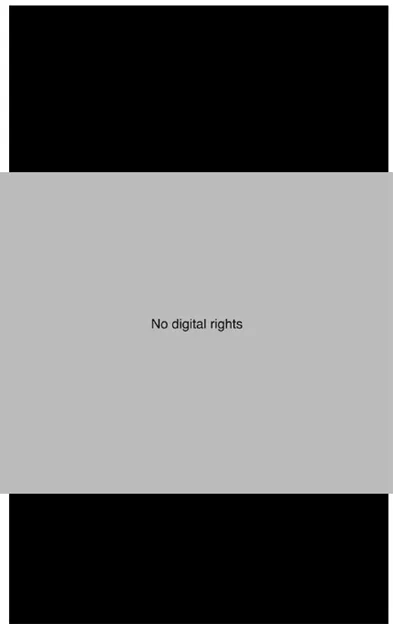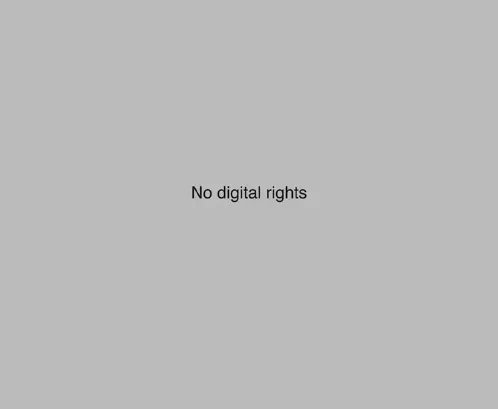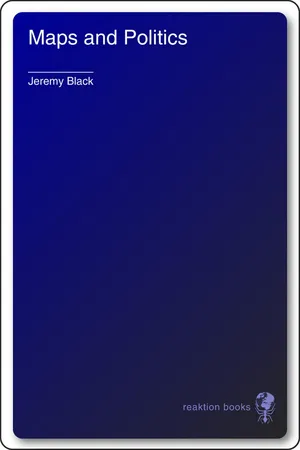![]()
1 Cartography as Power
Maps are selective representations of reality; they have to be. Even if maps were to be life-size photographs they would be distortions: a three-dimensional, spherical object, such as the globe, cannot be presented in two dimensions without its essence being altered, and this problem affects the mapping of parts of the globe. Yet, even if that problem could be overcome, and life-size, photographic, maps be produced in some futuristic virtual-reality technology, there would still be the question of how the photography/cartography should be presented. What perspective would be employed? Would there be shadows? Would the map be in darkness and, if not, why not? A landscape in twilight or darkness, the human presence, indeed power, etched in light, is as ‘realistic’ as the total vision of unclouded daylight, indeed more so, and yet this vision is employed in most maps (the most prominent exceptions being weather maps, which often include cloud). Furthermore, a ‘daylight’ map, whether life-size or not, with its misleading simultaneity of perception, is not affected by the methods by which humans on the ground, in ‘real life’, seek to create perceptions, to use light and lights to define space and create, or prevent, perceptions.
Maps are not life-size; they are models, not portraits, let alone photographs, of life. Most are minute compared with what they depict. As a result, map-makers have to choose what to show and how to show it, and, by extension, what not to show. The word ‘show’ is deliberately chosen. It conveys a sense of art and artifice, of the map-maker as creator rather than reflector. A map is a show, a representation. What is shown is real, but that does not imply any completeness or entail any absence of choice in selection and representation.
Some of the most striking modern images of the Earth are produced by orbiting satellites. Since the 1970s, NASA, the American National Aeronautics and Space Administration, has been producing such pictures, by a technique known as Remote Sensing by Landsat Imagery, which generates images from electro-magnetic radiations outside the normal visual range. These might appear natural maps, the product of human artifice, but essentially maps as photographs, photographs as maps. However, human intervention in the creation of the image is more direct than many viewers appreciate. For example, the use of different wave lengths leads to a stress on various aspects of the Earth’s surface. Infra-red is especially valuable for vegetation surveys and for water resources. Choice and context greatly affects the impression that is created. In particular, because the image and colour-range are unfamiliar to most viewers, the caption and accompanying text are especially important in influencing the responses of viewers.
A map is no mere illumination. A minuscule-scaled photograph from a high-flying aeroplane of, say, Eastern Ontario would be too crowded for it to be possible to discern much, other than a concentration of human activity in the form of light near the lake. As the aeroplane flew lower, more would be revealed in photographs, but a map is not a photograph. The choice of what to depict is linked to, and in a dynamic relationship with, issues of scale and purpose, and the latter issue is crucial. A map is designed to show certain points and relationships, and, in doing so, creates space and spaces in the perception of the map-user and thus illustrates themes of power. This is readily apparent with two very common types of map, which are produced at very different scales.
The first, the map of the world, or a region thereof, divides up its land space (although not generally the seas) in terms of territorial control and political authority: the map as assertion of sovereignty. States, such as France and Germany, are the building blocks of such a map. As will be discussed, other methods of organizing space at this scale, indeed of presenting political space, are ignored.
Such mapping, using states as building blocks, does not have to be explicitly political. For example, weather maps are one of the most familiar types of maps. They might seem totally removed from the world of politics. However, their frame of reference is generally that of a political unit, say, Italy or Spain, in part because they commonly appear in national newspapers or on national television or radio, or because such states are the most convenient units for discussion and depiction. Thus, in Britain, an inhabitant of Kent is provided with more information about the situation in distant Westmorland than in nearby Pas-de-Calais, which is in a different nation-state. The former is assumed to be more relevant, but that is not the essential reason for the scope of the weather map. Instead, it is a statement of the centrality of the national sphere even in fields in which the state, indeed the country, plays no role apart from the provision of the weather service.
The second very common type of map is that of a city or town, or a detailed part thereof. These maps are organized around streets; indeed, that is how they are indexed when produced together in street atlases, such as the London A–Z. The index plays a crucial role in such atlases. Railways are marked, but they are shown as thin lines and are not indexed. It is only on the imaginary island of Sodor, the scene of the ‘Thomas the Tank Engine’ stories, that a modern British cartographer can map roads alongside railways and make the former far less prominent.
In the ‘A–Z’-ing of life, habitations emerge as the spaces between streets. Differences within the city or town, for example of wealth, or environmental or housing quality, are ignored. The perceptions that create and reflect senses of urban space, often rival, contested and atavistic, are neglected, in favour of a bland uniform background that is described, and thus explained, insofar as there is any explanation, in terms of roads.
This is not a world of neighbourhoods, of upwardly mobile or downwardly mobile quarters, of areas largely inhabited by families or singles. Such blandness is necessary in order to highlight the roads, although, in addition, the network the roads thus display is misleading, because the detailed maps generally do not accept a hierarchy of routes, or, if they do so, do not give it sufficient prominence. A road map of a city does not depict roads in proportion to their traffic density, although it is increasingly common to distinguish main streets by colouring their surfaces. In addition, most city maps show major public buildings (typically in black), and thus allow city centres to be distinguished in a rough and ready way.
However, maps of cities are very much ground level. There is little, if any, suggestion of the vertical, and thus of the many who live and work in skyscrapers or more modest multi-storeyed buildings, and indeed of the transport problems these buildings pose and the links they offer (stairs/lifts). This elision of the vertical dimension of urban life is an aspect of the emphasis on ground-transport routes, particularly roads. The city is a space to be traversed, a region to be manipulated or overcome in the individual’s search for a given destination, not an area to be lived in and through. Far from being composed of neighbourhoods, the city is a sphere of distance to be negotiated, indeed overcome, by road. More generally, the structure, typology and density of activity in the city is neglected. 1
An A-Z road map does, of course, provide some hints about urban environmental quality. The presence of parkland is one important indicator. On the Nicholson Colour London Streetfinder (London, 1985) I use, there is an obvious contrast between the green spaces and graphic openness of the Hampstead area on p. 46 and Brixton (p. 90), where no green spaces are shown. They provide a hint of urban character for unvisited areas, and reinforce the perceptions already formed of parts of the town that have been visited.
This map from the 1996 Nicholson London Streetfinder reveals clearly the contrast between Hampstead, with its plentiful green spaces, and neighbouring areas, such as Kentish Town, that lack them. Other amenities, for example the views from the Heath and the way in which Hampstead literally looks down on its neighbours, are not revealed in this source.
Brixton, from the Nicholson London Streetfinder. This map provides no details of the dynamics, character and tensions of the community. Indeed, Brixton is presented as a group of routes. Without roads there are no locations.
Another possible indicator is the distance between streets. The wider the gap the more likely that there are gardens of some size, although this is by no means an invariable rule. Thus, on the A–Z Street Plan of Exeter the close-packed streets of the Mount Radford area contain property considerably more expensive than those in St Thomas. The map emphasizes streets and thus ignores housing quality and character. Political canvassers and estate agents in Exeter are aware of detailed variations among streets, of a geography of zones and boundaries, of ownership and residence patterns that do not appear on any street plan.
Similarly, historical atlases that employ such maps generally fail to address the human dimension. Mapping the Past – Wolverhampton 1557–1986 (published by Wolverhampton’s Library and Information Services Division in 1993) included as its last map a section of the Ordnance Survey map for the city centre. This showed the ring road and the accompanying text referred to the clearance of ‘sub-standard housing’. The accompanying destruction or dislocation of neighbourhoods left no trace in the map or text; the reader has to infer it.
The structure and density of activity of a city can also be ignored in typological maps that emphasize clarity, rather than scale and direction; for example the London Underground Journey Planner. This is based on a map devised in 1931 by Harry Beck, a draughtsman working for the London Underground. Prior to that, the maps issued by the Underground railways were designed to be accurate in terms of distance and direction. The first such map, produced to show all the Underground lines, as opposed to those simply for an individual company, was issued in 1908 and depicted the lines superimposed upon a central London street map. Such a background was dropped by the 1920s, but the map still lacked the diagrammatic form that Beck was to introduce.
The Ordnance Survey map for the city centre of Wolverhampton. The new ring road is visible but not the damage and disruption it led to.
Beck’s layout was inspired by scientific models, specifically by electrical-circuit diagrams, and depicted the lines as verticals, horizontals and 45° diagonals. His map was a success, and was used by London Transport for both station wall maps and pocket versions. Popular with users, the map offered an enlarged coverage of the central area, thus making it easier to understand routes and connections. The map also served another purpose. Some previous maps had had to exclude the outer, overground sections of the system or faced difficulties in including them, whereas the Beck layout included the entire system. By doing so, it shrank the apparent distance between suburbia and the inner city, and this achieved an important result at a time when suburban settlements, such as Edgware, were being developed. By making them appear closer, the Beck map ensured that movement there did not appear to be a case of leaving London. Instead, the ease of travel into the centre was emphasized, a visual effect that was encouraged by the use of straight lines on the map for the individual Underground lines.
The subject of a map reflects choice; so also do the scale, projection, orientation, symbolization, key, colour, title and caption. To imagine that there is a totally objective cartography is to deny the element and nature of choice and to neglect the assumptions present in choices, although these choices are often comprehensive within defined (and thus chosen) demarcations. Both assumptions and choices can require careful unpicking, as they entail subjective judgments, whereas the ideology of modern cartography, its raison d’être, is that of accuracy, which is generally seen as an aspect of objectivity; an impartial ‘scientific’ realization of reality. Most map-users see cartography as a science, a skilled, unproblematic exercise in precision, made increasingly accurate by modern technological advances. This approach is misleading, not least because it is based on a limited understanding of science. The limitations of the map-medium are more than ‘technical’ and non-controversial; the questions involved are more than merely a matter of which projection or scale to select, and with such choices seen as ‘technical’, rather than as involving wider issues.
It is possible, for example, to produce an accurate map of modern Italy that makes no allowance for the powerful fissiparous tendencies within the country. The administrative regions of Italy, regions that partake in the structure of state power, are mapped more frequently than the striking economic divisions between north and south, while Padania, the projected state of the separatist Northern League, proclaimed in 1996, appears on very few maps.
This essentially statist mapping was, and is, crucial, as the cartographic propagation of nations depends on a clear-cut identification of peoples and territory. To that end, space has to be understood as territory. The frequent reiteration of cartographic images of the state in, for example, rail and road maps and weather forecasting ensured that the shape and territorial outlines of states became clearly established. It is an educational process with a clear message about the natural way in which to order space. Such a process is enhanced by the comparable use of the shape of the state in advertising and in maps produced by commercial organizations.
In the 1980s and 1990s, the notion of objective cartography was challenged, in a series of arresting works. The most powerful of these was Denis Wood’s The Power of Maps (New York, 1992). The chapter titles indicated the theme of the book: ‘Maps Work by Serving Interests’; ‘Maps Are Embedded in a History They Help Construct’; ‘Every Map Shows This … But Not That’; ‘The Interest the Map Serves is Masked’; ‘The Interest is Embodied in the Map on Signs and Myths’; ‘Each Sign Has a History’; ‘The Interest the Map Serves Can Be Yours’. Wood’s theme is that maps reflect and sustain power.
This treatment of maps brought together the iconic tradition of decoding paintings and other works of art familiar from art history, with postmodernist concerns about the nature of text and the contingent nature of authorial intention. Wood’s book was dedicated to the memory of Brian Harley (1932–91), a British geographer whose example he acknowledged in the Preface.
Harley saw maps as essentially documents that contribute to the discourse of power, and that should be seen in that light. He treated cartography as a form of language, and maps as texts to be read and deconstructed in the post-structural and postmodern sense pioneered for literature, architecture and signs by Roland Barthes and Jacques Derrida.2 Cartography was linked to, and to be understood with reference to, ontology, epistemology, iconography and reception theory. His concern with discerning the rhetoric of maps offered a new layer of meaning for the cartographic project,3 and made it possible to relocate cartography in broader intellectual movements, and, in particular, in intellectual contexts other than those of the simple spread of knowledge.4
Moving away from the question of the accuracy of maps, Harley, especially in his later work, highlighted the nature of maps as instruments of power, in particular by drawing attention to their practical and symbolic role as assertions and communications of proprietorial and territorial rights.5 His analysis of the connections between power, knowledge and the mapping process drew on the work of the influential radical French philosopher Michel Foucault, and, in particular, on the problematizing of knowledge and its relationship with power. Foucault sought to use the notions, symbols and language of cartography, specifically of space, boundar...



